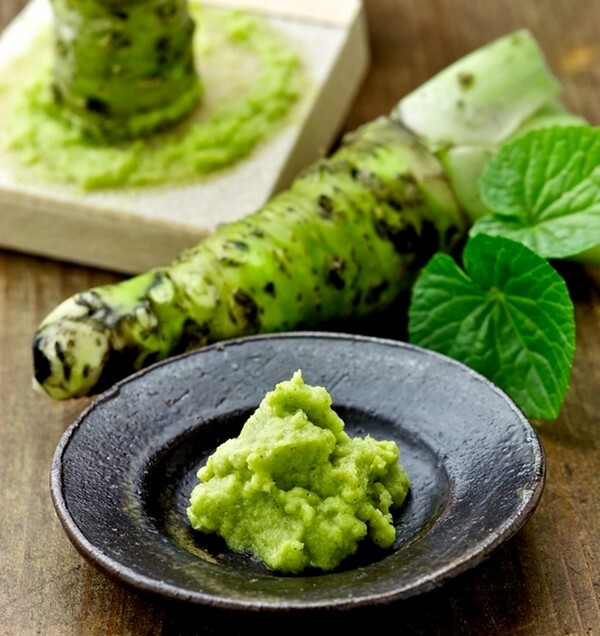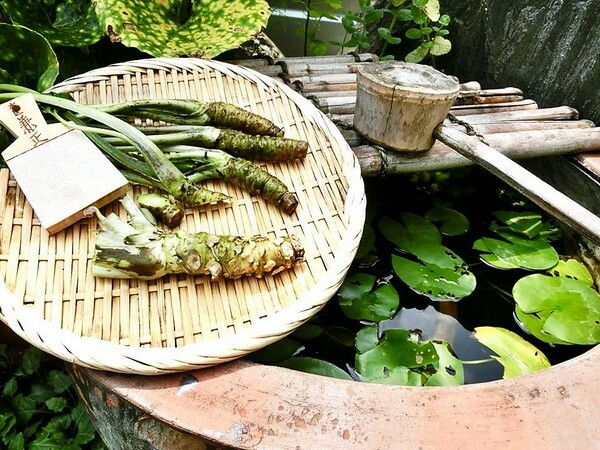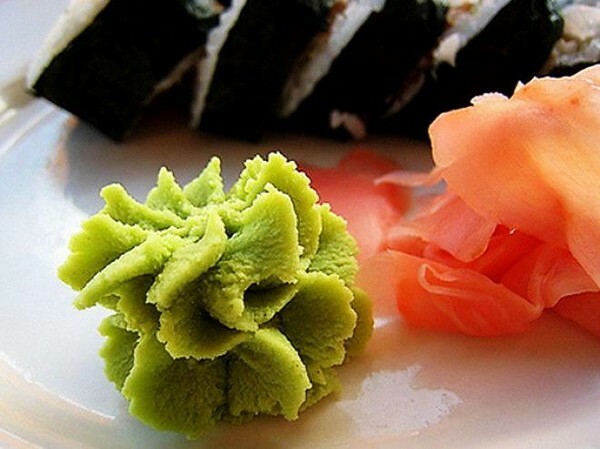As it turned out, not all connoisseurs of Japanese cuisine know, wasabi is horseradish or mustard. Most tend to the second option, but in fact this seasoning is a Japanese horseradish.

Characteristics of the plant
Wasabi is a herbaceous perennial of the Cabbage family, which belongs to the genus Eutrem. Its second name sounds like Eutrema Japanese. For the seasoning, only rhizomes are used, and in Japanese cuisine it is known as Japanese horseradish.
Note! However, in fact, this plant is not horseradish, although it belongs to the same family!
The wasabi plant has a simple leafy stem, the height of which can reach 45 cm. The leaves sit on long petioles, have a crenate edge, a rounded or cordate shape. The apical leaves can be divided into parts, the lower ones are always larger.
During the flowering period the plant is covered with small white flowers with bracts, which are collected in the apical brush. The flowers have ovate petals, the nail is extended. The flowering period falls on the middle-end of spring. After the formation of fruits. The fruit of wasabi is a pod with several seeds.
It grows in the coastal areas of the mountain streams. Cultivate this plant began around the tenth century. Today it is cultivated in New Zealand, Taiwan, China and the United States. Apply two types of agricultural technology - in the garden and in mountainous areas, when the plant is poured in cold water.

History of the Wasabi seasoning
Wasabi first appeared as a seasoning in 1396.Residents of Shizuoka rubbed the burning root and brought it as a gift to the future ruler. According to the constitution, he appreciated its taste and began to promote its spread throughout Japan.
Today, wasabi is no less popular than in ancient times, and is actively used in both Japanese and other kitchens. Crushed roots have a very strong flavor and a pungent taste, which is very similar to the sharpness of mustard. However, this Japanese horseradish wasabi can be purchased exclusively in Japan, where it grows in special conditions: the plant is pre-heated in water and kept in the temperature range from 10 to 17 ° C.For seasoning use three or four-year roots. Often the crushed rhizomes are combined with a small amount of soy sauce or are applied a thin layer on the rice, as in the cases of land.
What do we buy under the form of wasabi?
For a kilo of this wasabi it is necessary to pay about 200 euros. For this reason, most restaurateurs, whose establishments are located outside of Japan, prefer to use the so-called imitation - a seasoning based on the usual horseradish with the addition of spices and artificial colors. Such a product is available in the form of a powder or paste in tubes.
In the seasoning-imitation, as a rule, contains tartrazine, an additive known as the dye E 102, and mustard powder. Such imitations are sold in large packages and diluted with water according to the instructions. This product has nothing to do with this Japanese wasabi horseradish, and at best the share of this plant in such a seasoning will be only 2%.
Useful properties
This wasabi has a lot of useful properties. In the rhizomes concentrated a large amount of sinigrin, glucoside, ascorbic acid, dietary fiber, vitamin B6 and trace elements, among them magnesium, potassium, manganese and calcium. At the same time, this plant completely lacks cholesterol, sugars, saturated fats and a small amount of sodium. In addition, the composition of wasabi includes isothiocyanates. These substances are volatile compounds, which give the root a characteristic and aroma.
Thanks to this composition, this Japanese horseradish wasabi becomes useful for bronchial asthma - it suppresses coughing attacks. Isocyanates exhibit antibacterial properties and prevent the formation of dental caries. In addition, these same components have an antifungal effect.

In addition, isothiocytes can be used to prevent and treat malignant tumors. As the results of research conducted on animals show, the powder of these rhizomes is really effective against cancer tumors that form in the gastrointestinal tract. Isothiocyanates reduce the risk of cancer and destroy damaged cells.
Anticoagulant effect is provided due to the presence of essential oils in the plant composition - they stop the growth of platelets and do not allow thrombogenesis.
Note! The effectiveness of wasabi is about 30 times weaker than aspirin, but its anticoagulant effect is immediate, while aspirin begins to work only after half an hour!

As you can see, Japanese horseradish wasabi is not a useless plant. Thanks to the substances that make up its composition, it is able to become not only a tasty seasoning, but also a curative product. He will remove excess fluid from the body, improve digestion and keep the growth of pathogenic bacteria.
Contraindications
However, it should be remembered that wasabi is a very acute seasoning, which should be consumed moderately. Otherwise, you can provoke an increase in blood pressure.
There are also strict contraindications, which include:
- inflammatory processes in the gastrointestinal tract;
- diseases, which are accompanied by high acidity;
- kidney and liver disease.
